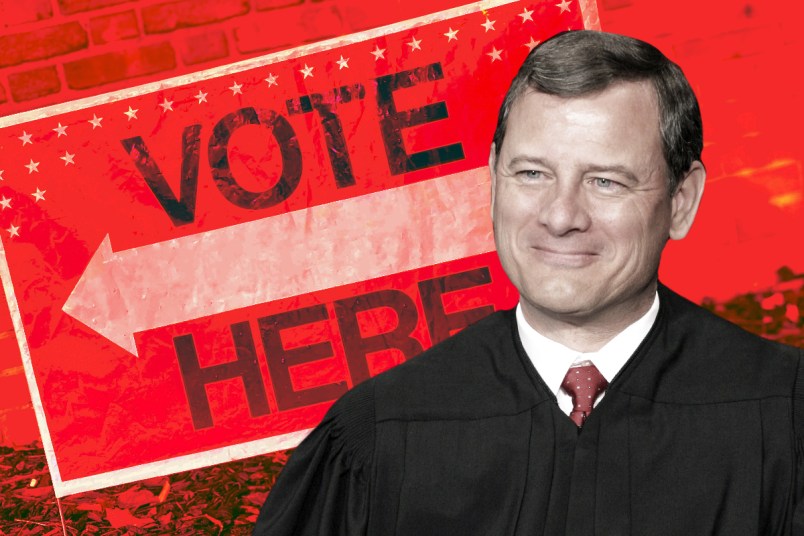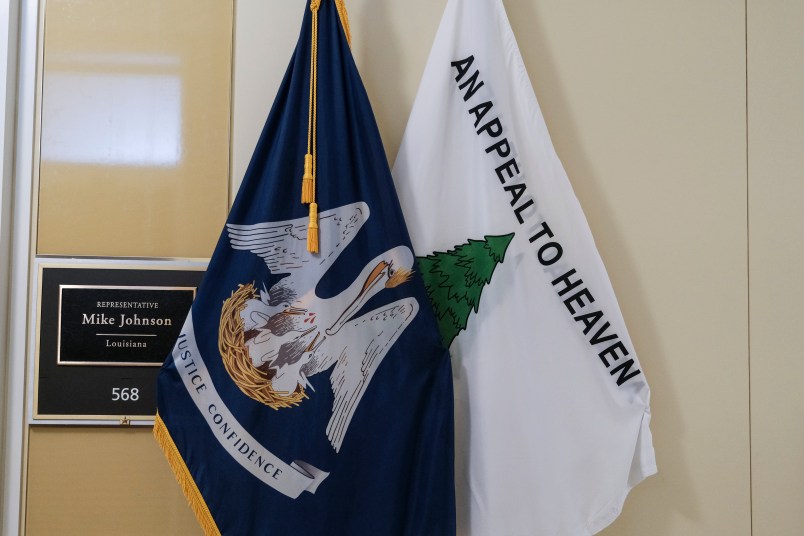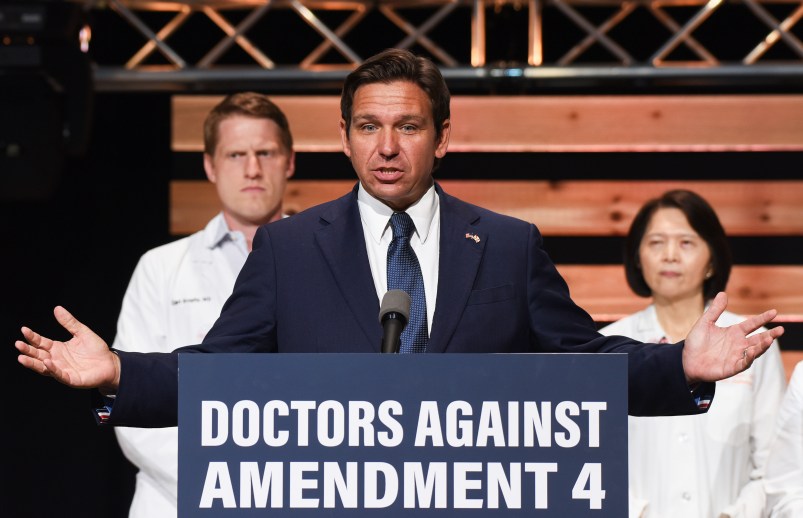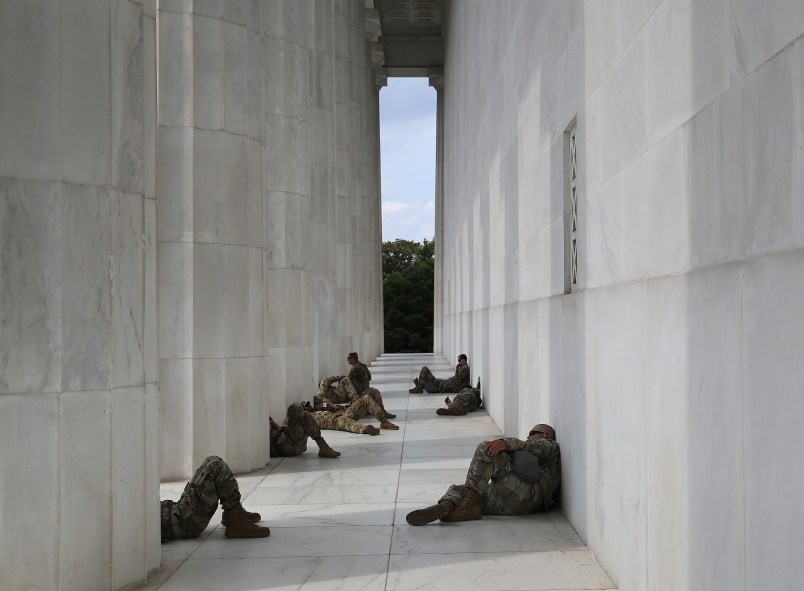This article is part of TPM Cafe, TPM’s home for opinion and news analysis. It was excerpted from “Justice Deferred: Race and the Supreme Court” by Orville Vernon Burton and Armand Derfner, published by The Belknap Press of Harvard University Press.
When the Supreme Court cut the heart out of the Voting Rights Act in 2013 in Shelby County, Alabama v. Holder, it cleared the way for the avalanche of voting restrictions we are seeing in 2021, in states like Georgia, Florida, Texas, and doubtless more to come. The Shelby County case continues to attract wide attention but few are aware of how the Supreme Court’s 5-4 majority abused the judicial process to reach its result. This excerpt from the new book “Justice Deferred” tells that story.
First enacted in 1965, the Act targeted the states with the worst records of voting discrimination, mostly in the South. One part ended literacy tests and thus quickly spurred the registration of more than a million minority voters in the region. After that time, however, the Act’s main protection was the “preclearance” requirement, which prevented those states from adopting new disenfranchising tactics; over four decades, the Act blocked more than a thousand new voting rules, the equivalent of a thousand successful lawsuits. Originally enacted for five years, the Act was renewed three times, each time supported by congressional hearings and held constitutional by the Supreme Court. In 2006, both houses of Congress voted almost unanimously to extend the Act again. That set up a new constitutional question.
When John Roberts became chief justice of the U.S. Supreme Court in 2005, he was no stranger to the Voting Rights Act. In 1981–1982, Roberts was special assistant to William French Smith, the attorney general in the Reagan administration. As one of his assignments, Roberts wrote memoranda opposing key parts of the Voting Rights Act. Although most of the debate at that time was about other provisions of the act, Roberts was also skeptical about the preclearance remedy.
A new challenge to the constitutionality of the Voting Rights Act, Northwest Austin Mun. Util. Dist. v. Holder (2009), soon reached the Supreme Court. The Court sidestepped the constitutional issue on a technical statutory ground. The decision in Northwest Austin may have seemed uncontroversial, but the opinion by Chief Justice Roberts was anything but routine. The main feature of the opinion was the invention of a doctrine that the chief justice called “equality of the states” or “equal sovereignty.” Such a doctrine had already been tried by South Carolina and thoroughly rejected by the Supreme Court in South Carolina v. Katzenbach (1966).
In the Northwest Austin case Chief Justice Roberts resurrected South Carolina’s “states’ rights” vision and declared it to be constitutional doctrine, even “fundamental.” He claimed support from the Supreme Court’s 1966 decision, but only by leaving out key words and thus changing the meaning of the quotation. Thus, his doctrine rested on a basis that really did not exist. The actual quotation from South Carolina v. Katzenbach is as follows, with brackets around the words omitted in the Northwest Austin opinion:
The doctrine of equality of States[, invoked by South Carolina,] does not bar [this approach, for that doctrine applies only to the terms upon which States are admitted to the Union, and not to the] remedies for local evils which have subsequently appeared.
The words left out by Roberts change the meaning of the quotation. Read fairly, the Katzenbach quote says there is no doctrine of “equality of states” except when a state is initially admitted to the Union, whereas Chief Justice Roberts’s quote says there is such a doctrine. Leaving these words out created a general doctrine of equality of states that did not exist before he created it with this misquotation.
After the Northwest Austin case, ideological opponents of the Voting Rights Act canvassed covered states, counties, and cities looking for a likely candidate to bring another lawsuit to a seemingly receptive Court. The candidate turned out to be Shelby County, Alabama, located in the suburbs of Birmingham. In Shelby County v. Holder (2013), the Supreme Court took the next step, actually striking down the entire preclearance procedure as carried out under the Voting Rights Act. The Supreme Court held that Congress had acted unconstitutionally in 2006 when it extended the preclearance remedy. This was the first race-based civil rights law to be held unconstitutional in more than a hundred years.
Chief Justice Roberts’s opinion for the 5–4 majority in Shelby County was the bitter fruit of the seeds planted four years earlier. The majority opinion in Shelby County quoted or cited the Northwest Austin case no fewer than twenty-six times. The “equal sovereignty” doctrine was the centerpiece of the Shelby County decision, and those words were repeated seven times. The chief justice did not repeat his misquotation of South Carolina v. Katzenbach, but he did rely on the defective doctrine supposedly supported by that case. Justice Ginsburg challenged the new doctrine, but she had only four votes.
Scholarly disapproval was swift. One scholar said the doctrine prompted “savage criticism not only from the left, but also from the right.” Stanford Professor Michael McConnell, who had been a court of appeals judge ap pointed by President George W. Bush, said of the equal sovereignty concept, “This is a nice idea; it might be on my list of desirable constitutional amendments. But it is not in the Constitution we have.” Richard Posner, a conservative appeals court judge appointed by Ronald Reagan, joined in:
“This is a principle of constitutional law of which I had never heard — for the excellent reason that . . . there is no such principle.” If his point had not been clear, he added, “It rests on air.”
The doctrine of equal sovereignty shifted focus away from the Fifteenth Amendment. The question in the case should have been whether the Voting Rights Act, as extended in 2006, was within — or was still within — Congress’s enforcement power under the Fifteenth Amendment. That would have been an easy question to answer because 200 years of constitutional doctrine make it clear that where the Constitution gives Congress certain power, the Supreme Court does not secondguess whether Congress’s use of that power is necessary or effective, only whether Congress has done something which is prohibited by the Constitution. In overruling a major portion of the Voting Rights Act, the Court was careful not to suggest that Congress was exceeding its Fifteenth Amendment power. Instead the Court changed the subject to equal sovereignty and there found a “prohibition” that enabled it to override Congress’s Fifteenth Amendment power. The doctrine of equal sovereignty thus became a weapon against the right to vote.
That was neither the end of the case nor the end of the Court’s errors. There was still a second issue. Equal sovereignty did not necessarily end the case, because the voluminous record compiled by Congress of continuing voting discrimination in the covered states might have been sufficient to justify their special coverage even under equal sovereignty. The Court disposed of that possibility by saying that the record was simply irrelevant because the types of voting discrimination (such as gerrymandering or city annexation of white but not Black neighborhoods) did not match the type of violations (barriers to registration and casting a ballot) on which the act’s coverage formula was based.
The majority failed to recognize that vote discrimination methods are not in separate compartments but form a spectrum or continuum of variations (whatever works). In 1965 Congress identified covered jurisdictions based on one type of discrimination, but Congress knew that variations — then unknown — would be coming along, and the preclearance procedure reflected Congress’s determination to block any new, substitute types of discriminatory changes. New and different methods of discrimination are precisely what preclearance was designed for. The Warren Court called it “the extraordinary stratagem of contriving new rules of various kinds for the sole purpose of perpetuating voting discrimination . . . in order to evade the remedies of the Act itself.” The Burger Court noted as early as 1971 that “gerrymandering and boundary changes had become prime weapons for discriminating against Negro voters.” It continued, “the history of white domination in the South has been one of adaptiveness, and the passage of the Voting Rights Act and the increased black registration that followed has resulted in new methods to maintain white control of the political process” — methods that were still being used when Congress renewed the act in 2006. The Burger Court recognized that literacy tests were quickly replaced by methods still common today, and the extensions of the act in 1970, 1975, and 1982 — all upheld by the Court — were based on the same type of congressional record that the Shelby County majority said was irrelevant. The linchpin of the majority opinion, that “40year–old facts” about voting discrimination have “no logical relation to the present day,” could not be more wrong.
The Shelby County majority correctly said, “the Act imposes current burdens and must be justified by current needs.” Congress, filled with men and women whose political life depends on knowing “current needs,” assessed those needs in 2006 and concluded the act was still needed because generationslong patterns of discrimination were not yet uprooted. That should have been enough for the Court. Instead, the Court far overstepped its role, contradicting Alexander Hamilton, who said, in Federalist 78, that even if “judiciary encroachments” should occur, they “could never be so extensive as to . . . affect the order of the political system.”
Justice Ginsburg, from the bench, remembered Martin Luther King Jr.’s statement about the “arc of the moral universe,” which supposedly “bends toward justice.” Ginsburg added that it can do so only “if there is a stead fast commitment to see the task through to completion.” In dissent, she also had a pithy rejoinder to the majority’s notion that voting problems were all but wrapped up: “Throwing out preclearance when it has worked and is continuing to work to stop discriminatory changes is like throwing away your umbrella in a rainstorm because you are not getting wet.”
The Court that struck down the Voting Rights Act was certainly different from earlier Courts — not just the Warren Court, but the Court as led by Chief Justices Hughes, Stone, and Vinson in the 1930s, ‘40s and early ‘50s. Those Courts consistently read the Constitution and laws broadly, even expansively, to favor civil rights claims to equality, in line with the Reconstruction constitutional amendments. It was even different from the Burger Court, where major rulings rejecting civil rights claims were leavened with some favorable rulings.
In 1989, in a dissenting opinion, Justice Blackmun made an observation that has seemed more prophetic with each passing day: “One wonders whether the majority still believes that race discrimination — or, more accurately, race discrimination against nonwhites — is a problem in our society, or even remembers that it ever was.”
Orville Vernon Burton is the prizewinning author of several books, including The Age of Lincoln. He is Judge Matthew J. Perry Jr. Distinguished Professor of History at Clemson University and Emeritus University Scholar and Professor of History at the University of Illinois.
Armand Derfner has been a civil rights lawyer for over fifty years. He has been counsel for, among others, the NAACP Legal Defense Fund (LDF) and the Mexican American Legal Defense and Educational Fund (MALDEF), and helped desegregate university systems and legislatures across the South. He argued his first Supreme Court case in 1968.
Copyright © 2021 by Orville Vernon Burton and Armand Derfner. Used by permission. All rights reserved.










OT-ish…The Supremes gave 7-2 decision against the case brought against Obamacare by Red states.
They didn’t rule on the merit, but on the standing.
First Roberts sabotaged voting rights then he killed them.
Roberts has ALWAYS been the affable, low-key Manchurian Justice, hatched in a rightwing test-tube ready to serve Corporate and NeoConfederate interests when the secret bell was rung. I’d also like to see the balance of his secret offshore bank acct.
Many have said this, the most important Republican in America is not Donald Trump but John Roberts.
That is everything Roberts does is entirely based not on the constitution or his oath of office but what will help the Republican Party increase its hold on power.
Make no mistake that the reason for this ruling is that overturning the affordable care act and taking away health care from 30,000,000 Americans, over 70% of them White people with a high school diploma or less, would be a big loser to the Republican Party.
That is why the Supreme Court led by Chief Injustice John Roberts refused to declare Obamacare unconstitutional, not because in fact the act is constitutional. For Roberts it is all politics and what is good for Republicans.